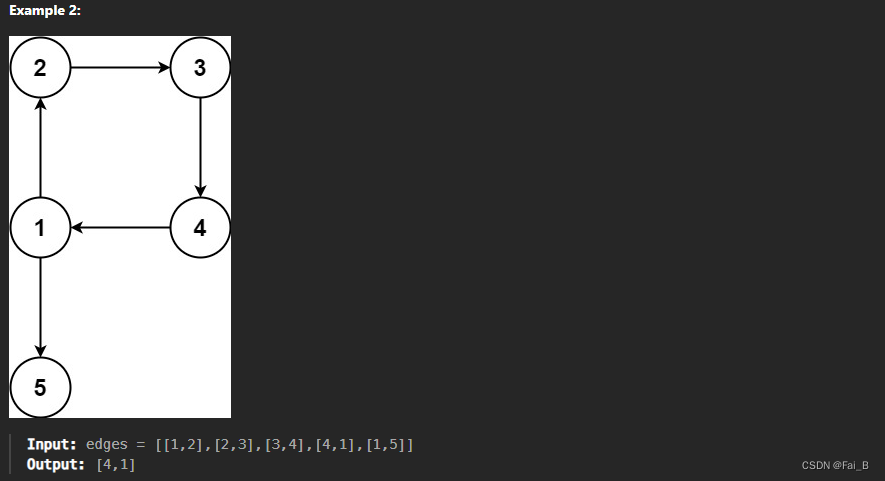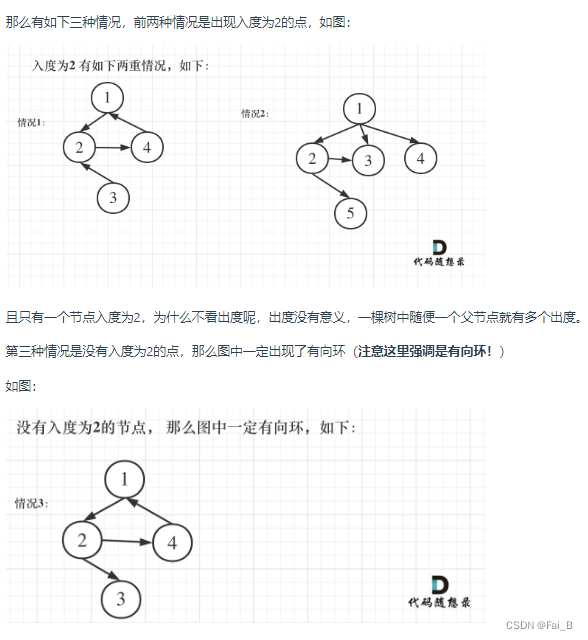684. Redundant Connection 685. Redundant Connection II
In this problem, a tree is an?undirected graph?that is connected and has no cycles.
You are given a graph that started as a tree with?n?nodes labeled from?1?to?n, with one additional edge added. The added edge has two?different?vertices chosen from?1?to?n, and was not an edge that already existed. The graph is represented as an array?edges?of length?n?where?edges[i] = [ai, bi]?indicates that there is an edge between nodes?ai?and?bi?in the graph.
Return?an edge that can be removed so that the resulting剩余 graph is a tree of?n?nodes. If there are multiple answers, return the answer that occurs last in the input.

?union - find: module:
def __init__(self):
"""
初始化
"""
self.n = 1005
self.father = [i for i in range(self.n)]
def find(self, u):
"""
并查集里寻根的过程
"""
if u == self.father[u]:
return u
self.father[u] = self.find(self.father[u])
return self.father[u]
def join(self, u, v):
"""
将v->u 这条边加入并查集
"""
u = self.find(u)
v = self.find(v)
if u == v : return
self.father[v] = u
pass
def same(self, u, v ):
"""
判断 u 和 v是否找到同一个根,本题用不上
"""
u = self.find(u)
v = self.find(v)
return u == vanswer:
class Solution:
def findRedundantConnection(self, edges: List[List[int]]) -> List[int]:
self.father = [i for i in range(len(edges) + 1)]
for i in range(len(edges)):
if self.is_same(edges[i][0], edges[i][1]): #主要逻辑,一个线段两头的father都相同这条线段就冗余redundant
return edges[i]
else:
self.join(edges[i][0], edges[i][1]) #线段
return []
def find(self, u):
if u != self.father[u]:
self.father[u] = self.find(self.father[u])
return self.father[u]
def join(self, u, v):
u = self.find(u)
v = self.find(v)
if u == v:
return
self.father[v] = u
pass #可省
def is_same(self, u, v):
u = self.find(u)
v = self.find(v)
return u == v?optimal:
class Solution:
def findRedundantConnection(self, edges: List[List[int]]) -> List[int]:
self.father = [i for i in range(len(edges) + 1)]
for i in range(len(edges)):
if self.find(edges[i][0]) == self.find(edges[i][1]):
return edges[i]
else:
self.father[self.find(edges[i][1])] = self.find(edges[i][0])
return[]
def find(self, u):
if u != self.father[u]:
self.father[u] = self.find(self.father[u])
return self.father[u]?
In this problem, a rooted tree is a?directed?graph such that, there is exactly one node (the root) for which all other nodes are descendants后人?of this node, plus every node has exactly one parent, except for the root node which has no parents.
The given input is a directed graph that started as a rooted tree with?n?nodes (with distinct values from?1?to?n), with one additional directed edge added. The added edge has two different vertices chosen from?1?to?n, and was not an edge that already existed.
The resulting graph is given as a 2D-array of?edges. Each element of?edges?is a pair?[ui, vi]?that represents a?directed?edge connecting nodes?ui?and?vi, where?ui?is a parent of child?vi.
Return?an edge that can be removed so that the resulting graph is a rooted tree of?n?nodes. If there are multiple answers, return the answer that occurs last in the given 2D-array.


?
?
class Solution:
def __init__(self):
self.n = 1010
self.father = [i for i in range(self.n)]
def find(self, u: int):
"""
并查集里寻根的过程
"""
if u == self.father[u]:
return u
self.father[u] = self.find(self.father[u])
return self.father[u]
def join(self, u: int, v: int):
"""
将v->u 这条边加入并查集
"""
u = self.find(u)
v = self.find(v)
if u == v : return
self.father[v] = u
pass
def same(self, u: int, v: int ):
"""
判断 u 和 v是否找到同一个根,本题用不上
"""
u = self.find(u)
v = self.find(v)
return u == v
def init_father(self):
self.father = [i for i in range(self.n)]
pass
def getRemoveEdge(self, edges: List[List[int]]) -> List[int]:
"""
在有向图里找到删除的那条边,使其变成树
"""
self.init_father()
for i in range(len(edges)):
if self.same(edges[i][0], edges[i][1]): # 构成有向环了,就是要删除的边
return edges[i]
self.join(edges[i][0], edges[i][1]);
return []
def isTreeAfterRemoveEdge(self, edges: List[List[int]], deleteEdge: int) -> bool:
"""
删一条边之后判断是不是树
"""
self.init_father()
for i in range(len(edges)):
if i == deleteEdge: continue
if self.same(edges[i][0], edges[i][1]): # 构成有向环了,一定不是树
return False
self.join(edges[i][0], edges[i][1]);
return True
def findRedundantDirectedConnection(self, edges: List[List[int]]) -> List[int]:
inDegree = [0 for i in range(self.n)]
for i in range(len(edges)):
inDegree[ edges[i][1] ] += 1
# 找入度为2的节点所对应的边,注意要倒序,因为优先返回最后出现在二维数组中的答案
towDegree = []
for i in range(len(edges))[::-1]:
if inDegree[edges[i][1]] == 2 :
towDegree.append(i)
# 处理图中情况1 和 情况2
# 如果有入度为2的节点,那么一定是两条边里删一个,看删哪个可以构成树
if len(towDegree) > 0:
if(self.isTreeAfterRemoveEdge(edges, towDegree[0])) :
return edges[towDegree[0]]
return edges[towDegree[1]]
# 明确没有入度为2的情况,那么一定有有向环,找到构成环的边返回就可以了
return self.getRemoveEdge(edges)?
本文来自互联网用户投稿,该文观点仅代表作者本人,不代表本站立场。本站仅提供信息存储空间服务,不拥有所有权,不承担相关法律责任。 如若内容造成侵权/违法违规/事实不符,请联系我的编程经验分享网邮箱:chenni525@qq.com进行投诉反馈,一经查实,立即删除!
- Python教程
- 深入理解 MySQL 中的 HAVING 关键字和聚合函数
- Qt之QChar编码(1)
- MyBatis入门基础篇
- 用Python脚本实现FFmpeg批量转换
- 年轻人2023消费图鉴,媒介盒子为你揭秘
- kubernetesr安全篇之Pod 安全性标准
- openssl3.2 - 官方demo学习 - kdf - scrypt.c
- 光耀未来 第一届能源电子产业创新大赛太阳能光伏赛道决赛在宜宾举行
- 教你用五步让千年的兵马俑跳上现代的科目三?
- 为什么在windows平台下将proto文件编译为py版本,然后拷贝到mac平台就不能用了,还要重新编译proto文件才可以
- Codeforces Round 916 (Div. 3)(A~E2)
- C 语言超全练习题(一): 初识C语言
- 5G_射频测试_参考规范(一)
- 线性代数-第五课,第六课,第七课,第八课